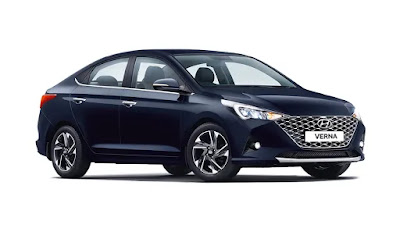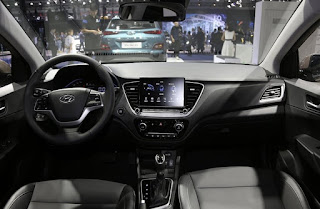A big part of Hyundai-Kia's strategy for dominating the Indian market
has been to have all bases covered with every new car they offer. We saw
it with the Kia Seltos and its innumerable variants, then in the Hyundai Creta and in the Nios/Aura twins. A similar situation has played out with the facelifted Hyundai Verna.
The highlight for this update is the fiesty new Verna Turbo that we've also just driven.
But Hyundai is also offering the facelifted Verna with its 1.5-litre
BSVI petrol and diesel options. Like with the Seltos/Creta, the petrol
can be had with a CVT and the diesel with a torque-convertor automatic
transmission. This aside from a six-speed manual for both. The result of
this is that there will always be a version of the Verna that perfectly
suits your needs.
And if your needs amount to largely having a comfortable, spacious car that'll fit into your daily grind easily then this petrol manual might be a good way to go. Its 1.5-litre motor loses just 5PS to the Turbo with 115PS at 6,300 rpm. The gap in torque is wider but still a respectable 145 Nm at 4,500 rpm. We drove it with the six-speed manual, and with this drivetrain, we were impressed by how this motor behaved around town. This is due to this engine's sharp low-end response. Combined with the light, progressive clutch and a shift action that has that typical Hyundai precision, setting off from traffic lights and such, is a brisk experience. In fact, our testing found this version to be a full second quicker to 100 kmph from standstill than the Turbo, but that has more to do with the Turbo's DCT limiting revs during full-bore launches. A situation you are unlikely to face very often in day-to-day driving.
And if your needs amount to largely having a comfortable, spacious car that'll fit into your daily grind easily then this petrol manual might be a good way to go. Its 1.5-litre motor loses just 5PS to the Turbo with 115PS at 6,300 rpm. The gap in torque is wider but still a respectable 145 Nm at 4,500 rpm. We drove it with the six-speed manual, and with this drivetrain, we were impressed by how this motor behaved around town. This is due to this engine's sharp low-end response. Combined with the light, progressive clutch and a shift action that has that typical Hyundai precision, setting off from traffic lights and such, is a brisk experience. In fact, our testing found this version to be a full second quicker to 100 kmph from standstill than the Turbo, but that has more to do with the Turbo's DCT limiting revs during full-bore launches. A situation you are unlikely to face very often in day-to-day driving.
Of course, the 1.5-litre petrol loses this advantage in part-throttle
manouveres, given its peak power is at a higher point in its rev-range.
Despite the weak mid-range, for a naturally aspirated motor, this
1.5-litre motor is extremely tractable. You can drive around in 2nd or
3rd gear all day in the city. It's only during quicker overtakes or
merging into faster expressway traffic will you need to drop down a few
gears to fully awaken the motor. This version loses out on the rear disc
brakes that the Turbo provides. There is a very mild drop in braking
performance as a result of this, but in practice some of the twitchy
brake feel of the Turbo is also gone, making for a more progressive
experience. Another advantage over the Turbo is real-world efficiency,
the 1.5 petrol returns 14.6 kmpl versus the Turbo's 13.9 kmpl.
We suspect that having chosen this version of the Verna, you will also
like to spend more time in the rear seat. The non-turbo Verna gets a
dual-tone black and beige interior. This livens up the already spacious
interiors further, especially in the rear. Here the reasonably large
glasshouse and good under-thigh support from the seats make for one of
the best rear-seat experiences in this class. There is enough space here
to fit in a tight three or a very comfortable two, although more
legroom would be welcome. The ride quality is very similar to the
pre-facelift Verna, largely stable although medium to large-sized
imperfections do filter through.
The petrol Verna will also hold up well if you like the occasional
family road trip. The light but progressive steering, the steady
high-speed demeanour, six-speed gearbox and a free-reving motor help in
this regard. Like in the Turbo, equipment levels are very good with the
new eight-inch infotainment, digitized instrument cluster and connected
car features. There's also the sunroof, wireless charging, ventilated
front seats and the hands-free boot release. Hyundai has been loading up
its cars with power sockets and charging ports and that convenience
carries over here too. We only wish that the petrol also got the front
parking sensor that are available in the Turbo. Otherwise, the stong
safety equipment list remains intact.
To round things off, the non-Tubo Verna gets slightly differentiated
styling to go with its more sedate demeanour. The wider new grille is
finished in brushed chrome, that doesn't look as flashy as you might
expect. The new LED headlamps and tailamps are identical to the Turbo
but the bumpers are different. The front gets different fog lamp inserts
and a wide chrome strip while the rear is a completely different unit
with different faux air skirts, a less-aggressive faux diffuser and
chrome detailing. The exhaust tip is also hidden here. There may not be
the added aggression of the Turbo here, but like in that version, these
changes have livened up the Verna's look.
The Verna was always one of the cars we liked most as a daily
commuter, in its long stint in the OD Garage last year. Of the many
engine options available with the sedan now, we think the petrol motor
will be the one to go for if you are looking for a well-equipped car
that will allow you a stress-free urban driving experience. Yes, the
Turbo's drivetrain may be more flexible, but for almost Rs 1.5 lakh less
ex-showroom, this could be the version that is the most value in the
new range. This is especially true now given that the long-term cost
advantages of running a diesel car have been largely diluted.
0-100 kmph (dry): 11.5s
Braking
100-0 kmph (wet): 47m/3.5s
In-gear acceleration
30-50 kmph (3rd): 4.5s
50-70 kmph (4th): 6.0s
60-80 kmph (5th): 11.3s
Fuel efficiency
City: 13.2 kmpl
Highway: 18.9 kmpl
Overall: 14.6 kmpl
The Numbers
Acceleration0-100 kmph (dry): 11.5s
Braking
100-0 kmph (wet): 47m/3.5s
In-gear acceleration
30-50 kmph (3rd): 4.5s
50-70 kmph (4th): 6.0s
60-80 kmph (5th): 11.3s
Fuel efficiency
City: 13.2 kmpl
Highway: 18.9 kmpl
Overall: 14.6 kmpl
| Price (Ex-Delhi) | Displacement | Transmission | Max Power(ps) | Max Torque(Nm) | Mileage |
| Starts Rs 9.31 Lakhs | 1493cc | Automatic | 115 | 250 | -NA- |



0 Comments
Post a Comment